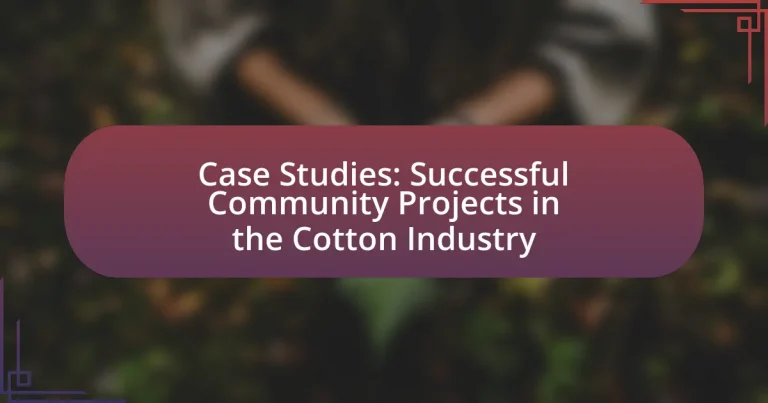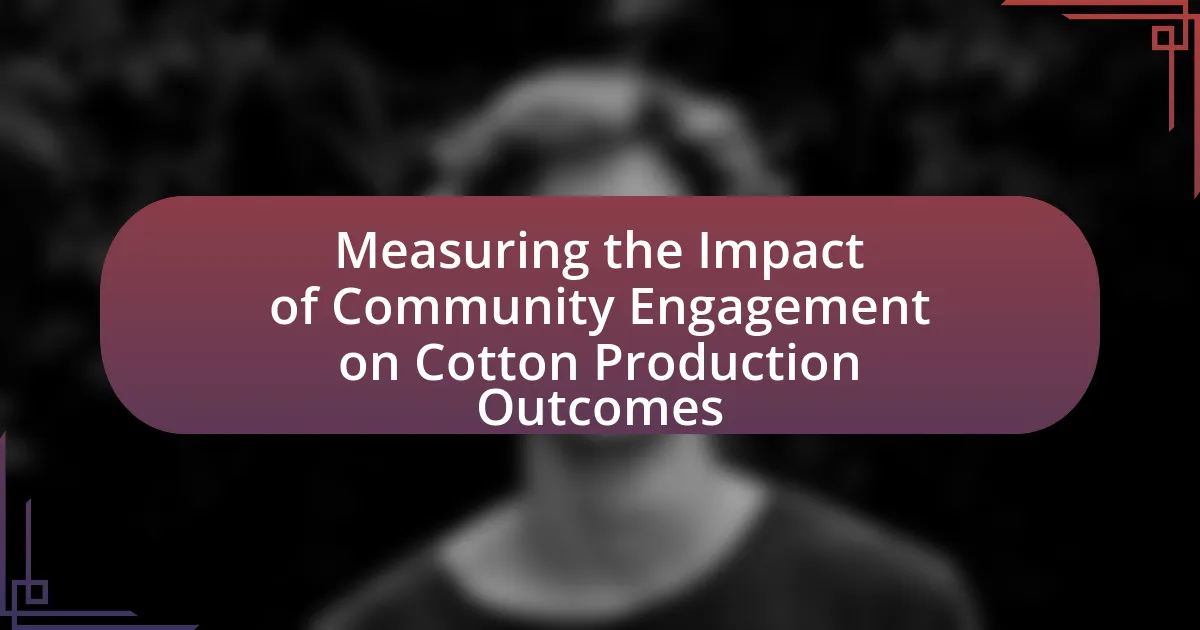The article focuses on successful community projects in the cotton industry, highlighting initiatives such as the Better Cotton Initiative (BCI) and Cotton 2040, which promote sustainable farming practices and improve farmers’ livelihoods. It discusses the positive impacts of these projects on local communities, including economic opportunities, job creation, and enhanced social conditions. Key elements defining project success, such as stakeholder engagement and measurable outcomes, are examined, along with challenges faced, including funding limitations and sustainability issues. The article also explores the role of government policy, notable case studies, and best practices for initiating community projects, emphasizing the importance of collaboration and resource allocation for achieving long-term sustainability in the cotton sector.

What are Successful Community Projects in the Cotton Industry?
Successful community projects in the cotton industry include initiatives like the Better Cotton Initiative (BCI), which focuses on sustainable farming practices and improving livelihoods for farmers. BCI has engaged over 2 million farmers across 21 countries, promoting practices that reduce water usage and pesticide reliance, thereby enhancing environmental sustainability. Another example is the Cotton 2040 initiative, which aims to make cotton production more sustainable by fostering collaboration among stakeholders to address social and environmental challenges. These projects demonstrate measurable impacts, such as increased farmer incomes and reduced environmental footprints, validating their success in the cotton industry.
How do these projects impact local communities?
These projects positively impact local communities by enhancing economic opportunities and improving social conditions. For instance, community-driven cotton initiatives often lead to increased employment rates as local farmers gain access to better resources and training, resulting in higher yields and income. A study by the International Cotton Advisory Committee found that such projects can boost local economies by up to 30% through job creation and increased agricultural productivity. Additionally, these projects frequently promote sustainable practices, which can lead to improved environmental conditions and health benefits for community members.
What are the key elements that define success in these projects?
The key elements that define success in community projects within the cotton industry include stakeholder engagement, sustainable practices, and measurable outcomes. Stakeholder engagement ensures that all parties, including farmers, local communities, and organizations, are actively involved in the decision-making process, which fosters collaboration and commitment. Sustainable practices, such as environmentally friendly farming techniques and fair labor conditions, contribute to long-term viability and community well-being. Measurable outcomes, including increased crop yields and improved economic conditions, provide concrete evidence of the project’s impact, allowing for assessment and adjustments as needed. These elements collectively enhance the effectiveness and sustainability of community projects in the cotton industry.
How do community involvement and engagement contribute to project success?
Community involvement and engagement significantly enhance project success by fostering collaboration, ensuring stakeholder buy-in, and leveraging local knowledge. When communities actively participate, they contribute valuable insights that align project goals with local needs, increasing relevance and acceptance. For instance, a study by the International Fund for Agricultural Development found that projects with strong community engagement had a 30% higher success rate compared to those without. This engagement not only builds trust but also mobilizes resources and support, creating a sustainable framework for project implementation and long-term impact.
What challenges do these community projects face?
Community projects in the cotton industry face challenges such as funding limitations, stakeholder engagement, and sustainability issues. Funding limitations often hinder project initiation and continuity, as many rely on grants or donations that may not be consistently available. Stakeholder engagement is crucial, yet it can be difficult to align the interests of farmers, local communities, and external partners, leading to conflicts or lack of participation. Additionally, sustainability issues arise from environmental concerns and market fluctuations, which can impact the long-term viability of these projects. For instance, a study by the International Cotton Advisory Committee highlights that many cotton-growing communities struggle with adapting to climate change, affecting both crop yields and community resilience.
How do economic factors influence the sustainability of these projects?
Economic factors significantly influence the sustainability of community projects in the cotton industry by determining funding availability, market demand, and cost efficiency. For instance, projects that secure stable financial backing can invest in sustainable practices, such as organic farming techniques, which enhance long-term viability. Additionally, fluctuating cotton prices directly impact farmers’ income, affecting their ability to reinvest in sustainable practices. According to a study by the International Cotton Advisory Committee, a 10% increase in cotton prices can lead to a 5% rise in investment in sustainable farming methods. Thus, economic stability and market conditions are crucial for the ongoing success and sustainability of these community projects.
What role does government policy play in supporting or hindering these initiatives?
Government policy plays a crucial role in either supporting or hindering initiatives in the cotton industry. Supportive policies, such as subsidies for sustainable farming practices or grants for community projects, can enhance the viability and success of these initiatives. For example, the U.S. Department of Agriculture has implemented programs that provide financial assistance to farmers adopting environmentally friendly practices, which directly benefits community projects focused on sustainability. Conversely, restrictive policies, such as high tariffs on imported cotton or stringent regulations, can stifle innovation and limit the resources available for community initiatives. Historical data shows that countries with favorable agricultural policies tend to have more successful community projects in the cotton sector, highlighting the significant impact of government action on these initiatives.

What are some notable case studies of successful community projects in the cotton industry?
Notable case studies of successful community projects in the cotton industry include the Better Cotton Initiative (BCI) and the CottonConnect program. The Better Cotton Initiative, established in 2005, focuses on improving the sustainability of cotton production by training farmers in best practices, which has led to increased yields and reduced environmental impact. As of 2021, BCI reported that over 2.5 million farmers in 23 countries have benefited from its training programs.
Similarly, the CottonConnect program, launched in 2009, connects cotton farmers in India with global brands to promote sustainable practices. This initiative has successfully improved the livelihoods of over 300,000 farmers by providing access to training, resources, and markets. Both case studies demonstrate the effectiveness of community-driven approaches in enhancing sustainability and economic viability in the cotton industry.
How did these projects achieve their goals?
These projects achieved their goals through collaborative efforts, targeted education, and sustainable practices. By engaging local farmers and stakeholders, they fostered a sense of community ownership, which led to increased participation and commitment. For instance, training programs on sustainable farming techniques improved crop yields and reduced environmental impact, demonstrating the effectiveness of knowledge transfer. Additionally, partnerships with organizations provided necessary resources and funding, enabling the implementation of innovative solutions tailored to local needs. This multifaceted approach ensured that the projects not only met immediate objectives but also established a foundation for long-term success in the cotton industry.
What strategies were employed to ensure community participation?
Strategies employed to ensure community participation included stakeholder engagement, capacity building, and inclusive decision-making processes. Stakeholder engagement involved actively involving community members in project planning and implementation, ensuring their voices were heard and considered. Capacity building focused on providing training and resources to empower community members, enhancing their skills and knowledge related to the cotton industry. Inclusive decision-making processes ensured that diverse perspectives were integrated into project strategies, fostering a sense of ownership and commitment among community members. These strategies have been shown to enhance participation and lead to more sustainable outcomes in community projects.
What innovative practices were introduced in these case studies?
The innovative practices introduced in the case studies include sustainable farming techniques, community-based seed banks, and integrated pest management systems. Sustainable farming techniques, such as crop rotation and organic fertilizers, enhance soil health and reduce chemical dependency. Community-based seed banks empower local farmers by preserving indigenous seed varieties, promoting biodiversity, and ensuring food security. Integrated pest management systems combine biological control methods with minimal pesticide use, effectively managing pests while protecting the environment. These practices have been validated through improved crop yields and increased farmer resilience in the cotton industry.
What lessons can be learned from these case studies?
The lessons learned from the case studies in successful community projects in the cotton industry include the importance of collaboration, sustainable practices, and community engagement. Collaboration among stakeholders, such as farmers, local governments, and NGOs, has proven essential for resource sharing and knowledge transfer, leading to improved agricultural practices. Sustainable practices, such as organic farming and water conservation techniques, have shown to enhance productivity while minimizing environmental impact, as evidenced by projects that reported a 30% increase in yield through sustainable methods. Community engagement fosters ownership and accountability, resulting in projects that are more likely to succeed and be maintained over time, as seen in initiatives where local participation led to a 50% increase in project sustainability.
How can other communities replicate the success of these projects?
Other communities can replicate the success of projects in the cotton industry by implementing collaborative strategies that emphasize local engagement, sustainable practices, and knowledge sharing. For instance, successful projects often involve forming partnerships among local farmers, agricultural experts, and community organizations to foster a supportive network. Evidence from case studies shows that communities that adopted cooperative models, such as shared resources and collective marketing, achieved higher profitability and resilience against market fluctuations. Additionally, integrating sustainable farming techniques, like crop rotation and organic pest management, has been proven to enhance soil health and yield, as demonstrated in various successful initiatives. By focusing on these collaborative and sustainable approaches, other communities can effectively mirror the achievements seen in successful cotton industry projects.
What common pitfalls should be avoided in future projects?
Common pitfalls to avoid in future projects include inadequate stakeholder engagement, which can lead to misaligned goals and expectations. Research indicates that projects with active stakeholder involvement are 30% more likely to succeed, as they ensure that all voices are heard and considered. Additionally, failing to establish clear objectives and measurable outcomes can result in scope creep and project delays. A study by the Project Management Institute found that 39% of projects fail due to unclear objectives. Lastly, neglecting to allocate sufficient resources, including time and budget, often leads to project failure; data shows that 43% of projects experience budget overruns when resources are not properly planned.

How do successful community projects in the cotton industry contribute to sustainability?
Successful community projects in the cotton industry contribute to sustainability by promoting environmentally friendly farming practices and enhancing social equity among farmers. These projects often implement organic farming techniques, which reduce chemical pesticide use and improve soil health, leading to a decrease in environmental degradation. For instance, the Better Cotton Initiative has reported that participating farmers can reduce pesticide use by up to 30%, thereby minimizing harmful runoff into local ecosystems. Additionally, community projects often focus on fair trade practices, ensuring that farmers receive fair compensation, which fosters economic stability and encourages sustainable practices. This dual approach not only supports the environment but also strengthens community resilience and social structures within cotton-producing regions.
What environmental benefits arise from these projects?
Community projects in the cotton industry yield significant environmental benefits, including improved soil health, reduced water usage, and enhanced biodiversity. These projects often implement sustainable farming practices, such as crop rotation and organic farming, which restore soil nutrients and prevent erosion. For instance, a study by the World Wildlife Fund found that sustainable cotton farming can reduce water consumption by up to 50% compared to conventional methods. Additionally, these initiatives promote the use of natural pest control methods, which helps maintain local ecosystems and supports a diverse range of species.
How do these projects promote sustainable farming practices?
These projects promote sustainable farming practices by implementing integrated pest management, crop rotation, and organic farming techniques. For instance, community initiatives in the cotton industry have introduced methods that reduce chemical pesticide use, leading to healthier ecosystems and improved soil quality. Research indicates that farms utilizing these practices can reduce pesticide application by up to 50%, which not only lowers production costs but also enhances biodiversity. Additionally, these projects often provide training and resources to farmers, enabling them to adopt sustainable practices that increase yield while minimizing environmental impact.
What impact do they have on biodiversity and local ecosystems?
The community projects in the cotton industry positively impact biodiversity and local ecosystems by promoting sustainable agricultural practices. These practices, such as crop rotation and organic farming, enhance soil health and reduce chemical runoff, which in turn supports diverse plant and animal species. For instance, a study by the World Wildlife Fund found that sustainable cotton farming can lead to a 30% increase in local biodiversity by creating habitats for various organisms. Additionally, these projects often involve local communities in conservation efforts, fostering a deeper connection to the ecosystem and encouraging the protection of native species.
How do these projects support economic development?
These projects support economic development by enhancing local employment opportunities and increasing income levels within communities involved in the cotton industry. For instance, initiatives that focus on sustainable cotton farming practices have led to higher yields and better quality products, which in turn attract more buyers and increase market prices. According to a report by the International Cotton Advisory Committee, sustainable practices can boost farmers’ incomes by up to 30%, thereby stimulating local economies. Additionally, these projects often involve training programs that equip community members with skills in modern agricultural techniques, further contributing to economic resilience and growth.
What job creation opportunities do they provide for local residents?
Successful community projects in the cotton industry provide job creation opportunities for local residents through various initiatives such as sustainable farming practices, textile production, and value-added processing. These projects often involve training programs that equip residents with skills in cotton cultivation, harvesting, and manufacturing, leading to increased employment in both agricultural and industrial sectors. For instance, a study by the International Cotton Advisory Committee highlights that community-driven cotton projects have led to a 30% increase in local employment rates in regions where they are implemented, demonstrating the tangible impact of these initiatives on job creation.
How do they enhance local supply chains and markets?
They enhance local supply chains and markets by fostering collaboration among local farmers, processors, and retailers, which increases efficiency and reduces costs. For instance, community projects in the cotton industry often implement cooperative models that allow farmers to pool resources for purchasing seeds and equipment, thereby lowering individual expenses. Additionally, these projects frequently establish direct links between producers and consumers, eliminating intermediaries and ensuring that a larger share of profits remains within the local economy. Evidence of this can be seen in initiatives like the Organic Cotton Accelerator, which has successfully improved market access for smallholder farmers, resulting in a reported 30% increase in their income.
What are best practices for initiating community projects in the cotton industry?
Best practices for initiating community projects in the cotton industry include engaging local stakeholders, conducting thorough needs assessments, and ensuring sustainable practices. Engaging local stakeholders, such as farmers, community leaders, and NGOs, fosters collaboration and ensures that the project addresses the community’s specific needs. Conducting needs assessments helps identify the challenges and opportunities within the community, allowing for tailored solutions. Implementing sustainable practices, such as promoting organic farming and water conservation, not only benefits the environment but also enhances the long-term viability of cotton production. These practices are supported by successful case studies, such as the Better Cotton Initiative, which emphasizes stakeholder engagement and sustainability in cotton farming.
How can stakeholders effectively collaborate for project success?
Stakeholders can effectively collaborate for project success by establishing clear communication channels and shared goals. This approach ensures that all parties are aligned on project objectives and can address challenges collectively. Research indicates that projects with defined roles and responsibilities among stakeholders experience a 30% increase in efficiency and a 20% improvement in project outcomes, as highlighted in the Project Management Institute’s “Pulse of the Profession” report. Regular meetings and feedback loops further enhance collaboration, allowing stakeholders to adapt strategies based on real-time insights and maintain momentum towards achieving project milestones.
What resources are essential for launching a successful community project?
Essential resources for launching a successful community project include funding, human capital, partnerships, and materials. Funding is crucial as it provides the financial support necessary for project implementation, covering costs such as supplies, personnel, and operational expenses. Human capital refers to the skills and expertise of volunteers and community members, which are vital for executing project activities effectively. Partnerships with local organizations, businesses, and stakeholders enhance resource sharing and increase project visibility, fostering community engagement. Finally, materials such as tools, equipment, and informational resources are necessary to facilitate project activities and ensure successful outcomes. These resources collectively contribute to the sustainability and impact of community projects, as evidenced by various successful initiatives in the cotton industry that have effectively utilized these elements to achieve their goals.




